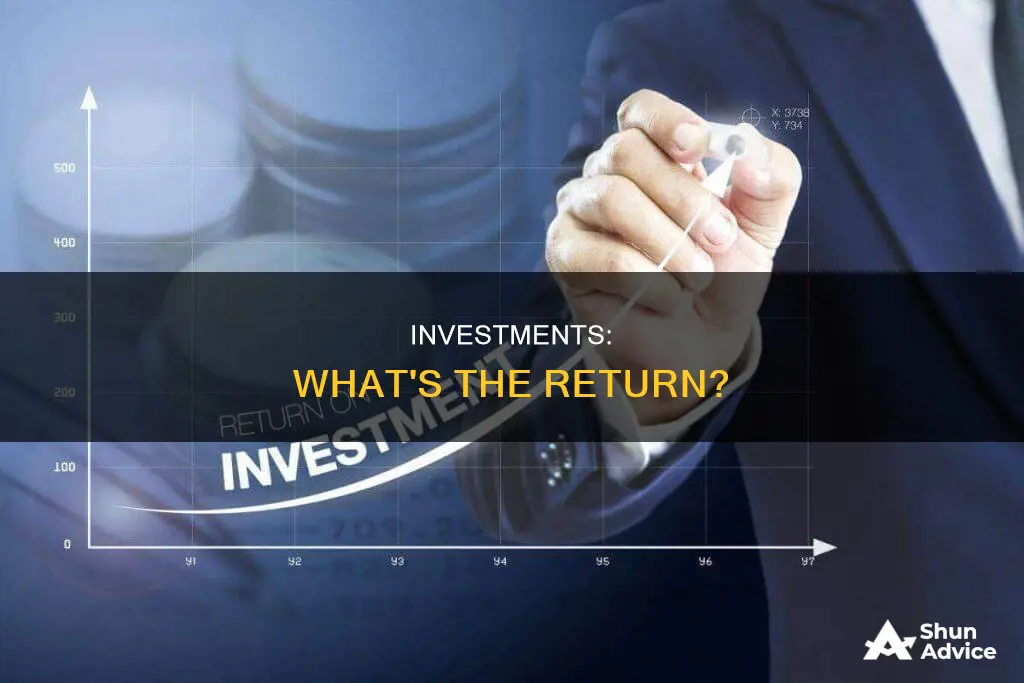
When it comes to investing, people generally expect to see a return on their investment (ROI). This can mean different things to different people, but generally, people expect their investments to make them money. For example, people may invest in stocks, bonds, or mutual funds, with the understanding that they could lose some or all of their money, but also that they could gain a greater investment return.
People also invest with the expectation of gaining financial security over the years and enjoying the benefits of managing their money. This may involve creating a financial roadmap, evaluating their comfort zone for taking on risk, and considering an appropriate mix of investments to protect against significant losses.
Additionally, people may seek expert advice from financial professionals or advisors to help them navigate the complex world of investing and make informed decisions. They may also look for certain characteristics in their investments, such as strong growth prospects, a good reputation, or a unique selling proposition.
Overall, while investing can be a great way to build wealth over time, it is important for individuals to understand the basics, do their research, and make informed decisions that align with their financial goals and risk tolerance.
| Characteristics | Values |
|---|---|
| Return on investment | 7-8% rate of return over a long-term basis |
| Risk tolerance | Low, medium, or high |
| Time horizon | Short-term or long-term |
| Knowledge of investing | Low, medium, or high |
| Amount to invest | Small, medium, or large |
| Investment type | Savings accounts, CDs, bonds, stock index funds, etc. |
| Investor involvement | Active or passive |
| Tax implications | Taxed now or later |

A financial roadmap
Before making any investment decisions, it's important to draw up a personal financial roadmap. This involves taking an honest look at your entire financial situation and figuring out your goals and risk tolerance, either on your own or with the help of a financial professional. Here are some key considerations for creating a financial roadmap:
- Evaluate your risk tolerance: All investments carry some level of risk, and it's important to understand that you could lose some or all of your money. Consider your comfort level with risk and whether you are investing for short-term or long-term financial goals. Generally, investing in asset categories with greater risk, like stocks or bonds, offers the potential for greater returns over the long term.
- Diversify your investments: Diversification is a key strategy to reduce risk. By investing in a variety of asset classes, such as stocks, bonds, and cash, you can protect yourself from significant losses. Diversification ensures that your portfolio is not overly dependent on the performance of a single asset class.
- Understand your financial situation: Take stock of your current financial situation, including your income, expenses, debt, and savings. This will help you determine how much you can comfortably invest while still meeting your day-to-day financial obligations.
- Set clear financial goals: Define your short-term and long-term financial goals. Are you saving for a house, retirement, or your child's education? Each goal will have a different time horizon and risk profile, which will influence your investment choices.
- Consider your time horizon: The time horizon for your investments will depend on your financial goals. If you are investing for the long term, you may be able to tolerate more risk and focus on growth-oriented investments. If you need access to your money in the short term, safer and more liquid investments may be more appropriate.
- Seek professional advice: Consider consulting a financial advisor or investing professional. They can provide guidance and expertise to help you make more informed investment decisions. A good financial advisor will explain your options, answer your questions, and help you create a comprehensive financial plan.
- Monitor and adjust your plan: Your financial roadmap should be a living document that you regularly review and update. As your life circumstances change, your investment strategies may also need to evolve. Reevaluate your risk tolerance, financial goals, and investment mix periodically to ensure they remain aligned with your current situation.
Creating a financial roadmap is a crucial step before making any investments. It helps you make informed and strategic decisions that are aligned with your financial goals and risk tolerance. Remember that investing involves risk, and there are no guarantees of returns. However, with a well-thought-out financial roadmap, you can increase your chances of achieving your financial objectives.
Century-Old Investment Strategies
You may want to see also

Risk tolerance
When people invest, they expect to see a return on their investment. However, all investments carry some degree of risk. Risk tolerance is a critical factor in investing, and it refers to the amount of risk an investor is willing and able to take on. It is influenced by factors such as age, income, investment goals, and time horizon.
An investor's risk tolerance is a measure of the degree of loss they are willing to accept within their investment portfolio. Those with a higher risk tolerance are often associated with investments in stocks, equity funds, and exchange-traded funds (ETFs). These investments offer the potential for higher returns but also come with greater volatility and uncertainty. On the other hand, investors with a lower risk tolerance tend to prefer investments with guaranteed returns, such as bonds, bond funds, and income funds.
It is important for investors to understand their risk tolerance as it helps them plan their investment portfolio and determine the types and amounts of investments they choose. Risk tolerance can be assessed through online surveys or questionnaires, and by reviewing historical returns for different asset classes to gauge volatility.
An investor's time horizon, or the length of time they plan to hold an investment, also plays a crucial role in risk tolerance. A longer time horizon typically allows for a higher risk tolerance, as there is more time to recover from potential losses. Conversely, shorter-term financial goals may require a more conservative approach with lower-risk investments.
Behavioral tendencies and comfort with uncertainty are other factors that influence risk tolerance. Some individuals may view risk as an opportunity for excitement and potential gains, while others may be more loss-averse and cautious. It is important for investors to be honest about their risk tolerance to build an investment portfolio that aligns with their comfort level.
Additionally, it is worth noting that risk tolerance and risk capacity are distinct concepts. While risk tolerance refers to an investor's willingness to take on risk, risk capacity refers to their financial ability to do so. Risk capacity can change over time, depending on personal and financial goals, while risk tolerance may remain relatively constant.
In conclusion, risk tolerance is a key consideration for investors as it guides their investment decisions and helps them strike a balance between potential returns and risk exposure. By understanding their risk tolerance, investors can make more informed choices that align with their financial goals and comfort level.
Successful People Invest in Themselves
You may want to see also

Diversification
It is also important to consider the time horizon and risk tolerance of the investor. Younger investors or those with a longer time horizon can afford to take on more risk by investing a larger proportion of their portfolio in stocks, which have higher growth potential but greater volatility. As investors approach retirement, it is common to shift towards less volatile investments like bonds, reducing the portfolio's overall risk.
Benefits of Diversification
Maintaining Diversification
Over time, the value of investments will fluctuate, and the portfolio may become unbalanced. For example, if the value of shares increases while bonds decrease, the portfolio will have a higher proportion of funds invested in shares, increasing the overall risk. Therefore, investors should periodically review and rebalance their portfolios to maintain their desired level of diversification and risk exposure.
There are various diversification strategies, but the common theme is investing in multiple asset classes. Stocks and bonds are two of the leading asset classes, and deciding how much to invest in each is a critical aspect of diversification. Other asset classes include real estate, commodities, and cryptocurrencies, which can further enhance diversification and increase potential returns.
Mutual funds, managed accounts, exchange-traded funds (ETFs), and listed investment companies (LICs) are simple ways to achieve diversification. These investment vehicles allow investors to access pre-made diversified portfolios or invest in a range of asset classes at a lower cost.
Investing in People: Debt as an Asset
You may want to see also

Tax efficiency
When investing, taxes can be one of the biggest expenses and can take a significant bite out of the returns on your investments. Therefore, tax efficiency is a crucial aspect that investors should consider.
Tax-Efficient Investing Strategies
Tax-efficient investing involves choosing the right investments and the right accounts to hold those investments. There are two main types of investment accounts: taxable accounts and tax-advantaged accounts.
Taxable Accounts
Taxable accounts, such as brokerage accounts, do not offer any tax benefits. However, they offer more flexibility than tax-advantaged accounts. With taxable accounts, you can withdraw your money at any time without incurring tax or penalty. The taxation of returns from these accounts depends on how long you hold an asset before selling it. Holding investments for over a year results in a more favourable long-term capital gains tax rate of 0%, 15%, or 20%, depending on your tax bracket. On the other hand, holding investments for a year or less subjects them to short-term capital gains tax, which is the same as your ordinary income tax rate.
Tax-Advantaged Accounts
Tax-advantaged accounts are either tax-deferred or tax-exempt. Tax-deferred accounts like traditional IRAs and 401(k) plans provide upfront tax breaks, allowing you to deduct contributions and pay taxes upon withdrawal in retirement. In contrast, tax-exempt accounts, such as Roth IRAs and Roth 401(k)s, involve contributions made with after-tax dollars. While there is no upfront tax break, investments grow tax-free, and qualified withdrawals in retirement are also tax-free. Tax-advantaged accounts have annual contribution limits and restrictions on withdrawals, with taxes and penalties for non-qualified withdrawals.
Tax-Efficient Investments
Some investments are more tax-efficient than others due to their tax structures.
Municipal Bonds
Municipal bonds are very tax-efficient. The interest income is typically exempt from federal income tax and may also be tax-exempt at the state and local levels.
Treasury Securities
Treasury securities, including Treasury Bills, Bonds, and Notes, are exempt from state and local taxes but are subject to federal taxes.
Tax-Efficient Funds
Certain funds are designed to minimize taxes. These funds employ strategies such as holding stocks for more than a year, practising tax-loss harvesting, and avoiding ordinary dividend-paying stocks.
Qualified Dividend-Paying Stocks and Mutual Funds
Qualified dividends are taxed as capital gains, while ordinary dividends are taxed as ordinary income. Investments held for over a year benefit from the long-term capital gains tax rate, which is generally more favourable for investors than income tax rates.
Exchange-Traded Funds (ETFs)
ETFs are passively managed, making them more tax-efficient than actively managed mutual funds. Additionally, their structure avoids generating capital gains taxes when securities are bought and sold, although investors pay capital gains tax when selling shares.
Tax-Efficient Asset Location
The location of your investments can also impact tax efficiency. Placing assets likely to result in significant tax bills in retirement accounts, and those with lower tax implications in non-tax-advantaged accounts, can help minimise taxes.
By incorporating tax-efficient investing strategies, investors can lower their tax bills and maximise their returns. This involves choosing the right types of accounts and investments to minimise tax obligations and maximise after-tax returns.
Education and Investment: Any Correlation?
You may want to see also

Long-term goals
When it comes to long-term goals, people expect their investments to grow their wealth over time, helping them meet their financial goals and increasing their purchasing power. This typically involves a careful balance of potential gains and risk involved.
For those with long-term financial goals, investing in asset categories with greater risk, like stocks or bonds, can lead to higher returns compared to less risky investments. For example, an S&P 500 index fund, which is based on a selection of the largest American companies, has historically returned about 10% annually and is considered one of the less risky ways to invest in stocks.
Additionally, people with long-term goals may consider investing in stocks that pay dividends, which offer a cash payout. Dividend stock funds are suitable for investors seeking income, particularly those who can remain invested for extended periods.
Another option for long-term investors is rental housing. This strategy requires the willingness to manage properties and deal with tenants. By making strategic purchases, gradually paying down debt, and increasing rents over time, investors can generate a substantial cash flow for retirement.
Long-term investors also need to consider their risk tolerance and time horizon. A longer time horizon allows for riding out market volatility and taking advantage of higher potential returns. It's important to ensure that investments are calibrated to the time horizon to avoid putting short-term funds at unnecessary risk.
Overall, long-term investors aim to build wealth, achieve financial goals, and increase purchasing power by carefully selecting investments that offer a balance of potential gains and risk.
Investments: Strategies for Persuasion
You may want to see also
Frequently asked questions
Historically, the S&P 500 has returned about 9.7% annually, but some experts believe that 7-8% is a more realistic expectation for the future.
There are many types of investments, including stocks, bonds, mutual funds, ETFs, and real estate. Each has its own risk and return profile, so it's important to understand the pros and cons of each before investing.
It depends on your financial goals, risk tolerance, time horizon, knowledge of investing, and how much you can invest. It's important to do your research and understand the risks and potential returns of any investment before committing your money.
The tax treatment of investments can vary depending on the type of investment and the jurisdiction. In some cases, you may be able to reduce the amount of tax you pay by investing in certain types of tax-advantaged accounts, such as IRAs or 401(k)s.
Working with a financial advisor can be beneficial, as they can provide expertise and guidance tailored to your specific situation. However, it's important to do your research and find an advisor who is reputable and who has your best interests in mind.







